

A new report has offered insights on the disparities in collision claims frequency and repair procedures between electric vehicles (EVs) and internal combustion engine (ICE) automobiles.
Published by Mitchell, a technology and information provider serving the P&C claims and collision repair sectors, the report found that repairable claims frequency for EVs rose 1.49% in the US and 2.64% in Canada during the second quarter of the year.
The average severity for all EVs was higher by US$963 in the US and US$1,328 in Canada compared to cars powered by ICE. This differential became more pronounced when specifically analyzing Tesla models, reaching US$1,589 and US$1,600 respectively.
Ryan Mandell, director of claims performance at Mitchell, said it isn’t surprising that claims severity for repairable EVs is outpacing ICE alternatives.
However, he noted that EVs are less likely than ICE vehicles to be non-drivable following an accident because they have fewer moving parts, even with greater interconnectivity between components.
“Unless an EV gets hit from behind, it has a higher likelihood of drivability,” said Mandell. “Differences like these will have a dramatic effect on the auto insurance and collision repair markets, given the recent growth in EV adoption.”
US EV sales has set a record in the last quarter, according to figures from Cox Automotive, with nearly 300,000 battery-electric vehicles sold. This is a 48.4% increase over the same period in 2022.
While the rate of EV adoption has been slower in Canada, the International Energy Agency noted that global EV sales are likely to scale up to 14 million units in 2023, with a projected acceleration in new purchases during the second half of the year.
Mitchell’s latest report also focused on the utilization of original equipment manufacturer (OEM) parts. It found that 90.75% of repairable EVs rely on such components compared to 66.50% of ICE automobiles.
Moreover, the percentage of parts that were repaired versus replaced in EVs was lower at 13.49% compared to 19.20% for ICE-powered vehicles.
The report additionally highlighted the role of paint refinishing labour hours in driving collision claim expenses. EVs recorded an average of 8.51 refinish hours in Q2, slightly exceeding the figure of 8.02 for ICE automobiles.
What are your thoughts on this story? Feel free to comment below.
